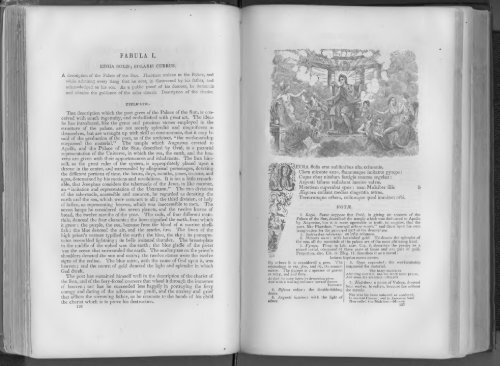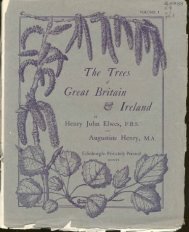THE METAMORPHOSES OF PUBLIUS OVIDIUS NASO
THE METAMORPHOSES OF PUBLIUS OVIDIUS NASO
THE METAMORPHOSES OF PUBLIUS OVIDIUS NASO
You also want an ePaper? Increase the reach of your titles
YUMPU automatically turns print PDFs into web optimized ePapers that Google loves.
FABULA I.<br />
REGIA SOLIS; SOLARIS CURRUS.<br />
A description of the Palace of the Sun. Phaethon arrives at the Palace, and<br />
while admiring every thing that he sees, is discovered by his father, and<br />
acknowledged as his son. As a public proof of his descent, he demands<br />
and obtains the guidance of the solar chariot. Description of the chariot.<br />
EXPLICATIO.<br />
<strong>THE</strong> description which the poet gives of the Palace of the Sun, is con<br />
ceived with much ingenuity, and embellished with great art. The ideas<br />
he has introduced, like the gems and precious stones employed in the<br />
structure of the palace, are not merely splendid and magnificent in<br />
themselves, but are wrought up with skill so consummate, that it may be<br />
said of the production of the poet, as of the architect, " the workmanship<br />
surpassed the material." The temple which Augustus erected to<br />
Apollo, and the Pakce of the Sun, described by Ovid, is a pictorial<br />
representation of the Universe, in which the sea, the earth, and the hea<br />
vens are given with their appurtenances and inhabitants. The Sun him<br />
self, as the great ruler of the system, is appropriately placed upon a<br />
throne in the centre, and surrounded by allegorical personages, denoting<br />
the different portions of time, the hours, days, months, years, seasons, and<br />
ages, determined by his motions and revolutions. It is not a little remark<br />
able, that Josephus considers the tabernacle of the Jews, in like manner,<br />
an " imitation and representation of the UNIVERSE." The two divisions<br />
of the tabernacle, accessible and common, he regarded as denoting the<br />
earth and the sea, which were common to all; the third division, or holy<br />
of holies, as representing heaven, which was inaccessible to men. The<br />
seven lamps he considered the seven planets, and the twelve loaves of<br />
bread, the twelve months of the year. The vails, of four different mate<br />
rials, denoted the four elements; the linen signified the earth, from which<br />
it grew; the purple, the sea, because from the blood of a marine shell<br />
fish ; the blue denoted the air, and the scarlet, fire. The linen of the<br />
high priest's vesture typified the earth; the blue, the sky; its pomegra<br />
nates resembled lightning; its bells imitated thunder. The breast-plate<br />
in the middle of the ephod was the earth; the blue girdle of the priest<br />
vas the ocean that surrounded the earth. The sardonyxes on the priest's<br />
shoulders denoted the sun and mocn; the twelve stones were the twelve<br />
signs of the zodiac. The blue mitre, with the name of God upon it, was<br />
heaven; and the crown of gold denoted the light and splendor in which<br />
God dwelt.<br />
The poet has sustained himself well in the description of the chariot of<br />
the Sun, and of the fiery-footed coursers that wheel it through the immense<br />
of heaven; nor has he succeeded less happily in portraying the fiery<br />
energy and daring of the adventurous youth, and the anxiety and grief<br />
that afflicts the sorrowing father, as he commits tc the hands of his child<br />
the chariot which is to prove his destruction.<br />
126<br />
;EGIA Sotis erat sublimibus alta columnis,<br />
£ Clara micante auro, flammasque imitante pyropo :<br />
Cujus ebur nitidum fastigia summa tegebat :<br />
Argenti bifores radiabant lumine valvse.<br />
M:iteriem superabat opus : nam Mulciber illic<br />
^Equora crelarat medias cingentia terras,<br />
Terrarumque orbem, coslumque quod imminet orbi.<br />
1. fiegia. Some suppose that Ovid, in giving nn account of the<br />
Palace of the Sun, described the temple which was dedicated to Apollo<br />
by Augustus, but it is more agreeable to truth, to suppose, that the<br />
poet, like Phaeihon, " concipit trthtro mente," and drew upon his own<br />
imagination for the principtil part ot the description.<br />
1. Sublimitus columnis: on lofty columns.<br />
2. Alicante auro : with burnished gold. To denote the splendor of<br />
the sun, all the materials of the palace are of the most glittering kind.<br />
2. Pyo/ie. Pliny, in Lib. x\iv. Cap. 8, describes the pyrope as a<br />
mixed metal, composed of three parts of brass and one part of gold.<br />
Propcrtius, also, Lib. iv. Elcg. 11, describes it as a metal:<br />
By others it is considered a gem. The<br />
etymology is tip, fre, and













